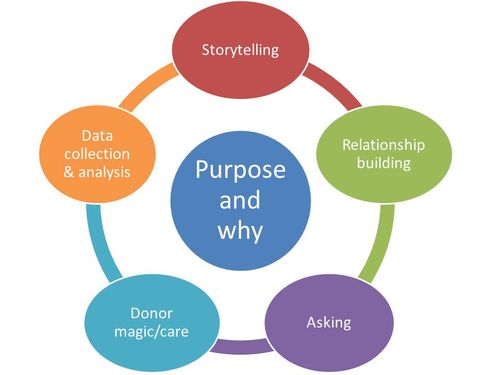
I found a very helpful graphic and writing from Craig Linton – www.fundraisingdetective.com – and I wanted to pass it on to you because Craig summarizes, in a very succinct way, the why for major gifts and the how to do major gifts (what you need to pay attention to).
 He starts out by stating: “I’m convinced 2015 will be the year when fundraisers will be forced to implement the principles of relationship fundraising rather than just say the right things about them. The reason? The ever rising cost of donor acquisition and increasing attrition.”
He starts out by stating: “I’m convinced 2015 will be the year when fundraisers will be forced to implement the principles of relationship fundraising rather than just say the right things about them. The reason? The ever rising cost of donor acquisition and increasing attrition.”
This is the why. Donor attrition is very high, and replacing those donors that go away is very expensive. Jeff and I have written extensively about why the donors are going away, but let me repeat it: the donor does not know she made a difference. THAT is why she went away. I think if more MGOs actually believed this fact, they would pay more attention to their caseload donors. But they don’t believe it – so they focus on getting the money rather than telling the donor he made a difference, and then they wonder why their numbers are down. Pretty basic. But I digress.
Back to Craig’s graphic and writing. Craig’s big emphasis is on relationship fundraising. And that breaks down into six major points:
- At the core is to make sure you state the purpose and the why for what you are doing. Jeff and I find too many MGOs that don’t have this right. We ask them: “So, why does your organization exist? What societal problem is your organization addressing?” And often, the blather that comes out is very confusing and disappointing. Please work on this. It is so important to the donor’s understanding of who you are and why you are. Practice saying it with other MGOs or someone in the office. Say it, and let them tell you if it sounds convincing and motivating. Did your explanation cause an emotion in the other person? If not, work on it.
- Make sure your decisions about the donor are fact-based. This implies that you are collecting data and analyzing the information. This data is not only actual information about what the donor has done for the organization; it is also a record of “touches” and visits. It is wealth information, connections, giving cycles, etc. Facts are good and friendly.
- Gather stories, and tell them. Stories of a lives changed or a lake or animal saved are the fuel in the engine of relationship fundraising. They bring the problem and the solution to life. They help the donor relate. They cause emotion. They are the very thing that moves the donor to action. They are essential in successful major gift fundraising.
- Build the relationship. This seems like a no-brainer, but it is hard to do. First, it requires that you not focus on the money. Get your mind off the money when you are talking with the donor. Be genuinely interested. Look for connection points. Ask questions. If the donor is interested in history, find the latest and best history book, buy it and send it to them. If the donor’s spouse has been sick, calendar yourself to ask how he is doing. Be thoughtful. Be kind. Be present. Be interested. That is what relationship is. Then in that context, uncover and talk about the donor’s interests and passions. This will lead to the money. Relationship first.
- Asking. You do have to ask. But if you have done all the other things mentioned so far in this post, the asking will follow naturally and easily, because it will come from your deep desire to fulfill the donor’s interests and passions.
- Lastly (and so important) is, as Craig puts it, donor magic and care. This is continuing your relationship-building practice and being thoughtful with one additional item – telling the donor she made a difference. The donor absolutely needs to know that the gift she gave to your organization actually did some good. I suspect the reason Craig put the word “magic” into the equation is because this is where you can do something really special for the donor – you can put some magic into the relationship. One MGO we know did this for a donor who gave a substantial gift to build a home for single moms. In bold black letters, he repeatedly wrote the following on the wood studs of the home “this is the house that DONOR NAME built” then took a picture of it along with a picture of some of the single moms who would benefit – he used this to thank the donor for his generous gift. It is true the studs would eventually be covered by drywall, but the donor knew his name was forever imprinted on the house. Donor magic. All you need to do in this area is to be thoughtful and caring. And tell the donor that their giving is actually doing something. This is so important.
Jeff and I suggest that you make 2015 the year of relationship fundraising with your caseload donors. Print out the graphic above and post it near you, so that you are regularly reminded to do work in all six of these areas. It will help you and your donor – and you will reach the financial goals you have set for this year.
Richard







Fabulous article! This is the essence of what being a Major Gift Officer is all about – should be required reading.
Thank you –
Dear Richard and Jeff, i’m just catching up on my reading and wanted to say a big ‘thank you’ for mentioning my article on relationship fundraising.
I’m glad you found the graphic useful. You’re right about the word ‘magic’ – I deliberately use that as I think the best fundraisers go beyond what is expected and try to create ‘wow’ moments for their donors, which in turn leads to word of mouth, donor satisfaction and increased loyalty.
Thanks again for the mention and keep up the great work!
Craig